The numeral seven, in the ancient world, symbolized completion…perfection. Perhaps not coincidentally, the Nissan Z is in it’s 7th generation and it’s pretty close to perfection. Of course having been re-imagined 7 times over the last 56 years, there’s been a lot of time to get things right and it’s obvious that Nissan has been paying attention to it’s history and what buyers want.
Take the design for instance. After years of increasingly swoopy designs Nissan reached back to the original Fairlady design for inspiration. From the square-boxed grill and faired-in headlights to the fastback rear glass and trunk lip spoiler, it borrows heavily but doesn’t rely completely on it’s heritage. There are other lines in the sheetmetal that complement the design cues. The hood has some crease lines that give it a squared strength. Some subtle crease lines down the sides provide some quiet swoopy drama that complements the fastback design. It’s a good look and going back to the beginning for inspiration shows that Nissan hasn’t forgotten it’s roots. Our car arrived in Bayside Blue and it was gorgeous. The wheels are stylish and large, filled out with large brake discs and large painted brake calipers. It’s a good look that earned us more than a few thumbs up while we had it.
Inside is a stylish interior that provided with us with comfortable environment for the week that we had it. Primarily done in black, Nissan colorblocked the interior with bright blue leather and suede seats, blue suede door pockets, and blue leather lower dash panels. It really looks cool. The digital display is dominated by a large tachometer, with oil pressure, oil temp, coolant temp, and differential oil temp gauges set to the right of it. To the left of the tach is driver’s choice of G-meter, mileage meter, or trip meter. Across the top of the dash are analog gauge pods displaying turbo pressure, turbo speed, and battery charge. A 9” digital infotainment display dominates the center stack. It’s clear and intuitive to use. Beneath the display are HVAC control dials for fan speed, temperature, and active vent selector. Standing out conspicuously in the middle of the center console was possibly the most beautiful part of the whole interior: a six-speed manual shifter (thanks, Nissan!).
Under the hood lies a twin-turbo V6. It makes 400hp and 350 lb-ft of torque, which is distributed through the manual transmission (with an Exedy performance clutch) to the rear wheels, like all Z models since it’s inception. It’s a great engine, very flexible and torquey. No matter what gear you’re in or where you are on the tachometer, floor it and the engine responds immediately. A bigger rush comes on around 4500 and propels it ahead even faster than you expect. It’s a magnificent engine and we relished planting our right foot every chance we got.
In the wheel wells reside some gorgeous 19” lightweight Rays wheels, wrapped in sticky Bridgestone Potenzas. Inside of those wheels are some performance brake discs and four-piston calipers up front and two-piston calipers in back. Behind all that are un-equal length aluminum A-arms in front and a trick multi-link system in back. It’s essentially textbook modern suspension and brakes designed by people who love high-performance driving.
Climb inside and the seat bolsters feel substantial, like they’ll hold you in place during some radical directional changes. The seat controls are a mix of electric and manual – the electric controls move the seat forwards and backwards and adjust the seatback, while the manual knobs adjust the attitude of the seat bottom. The seats are heated. I happened to have it when temps were in the mid-nineties so didn’t get around to using the heating option. Ventilated seats would have been terrific but the A/C did a nice job of keeping the cabin cool. The HVAC system has automatic temp control so you can set it and forget it.
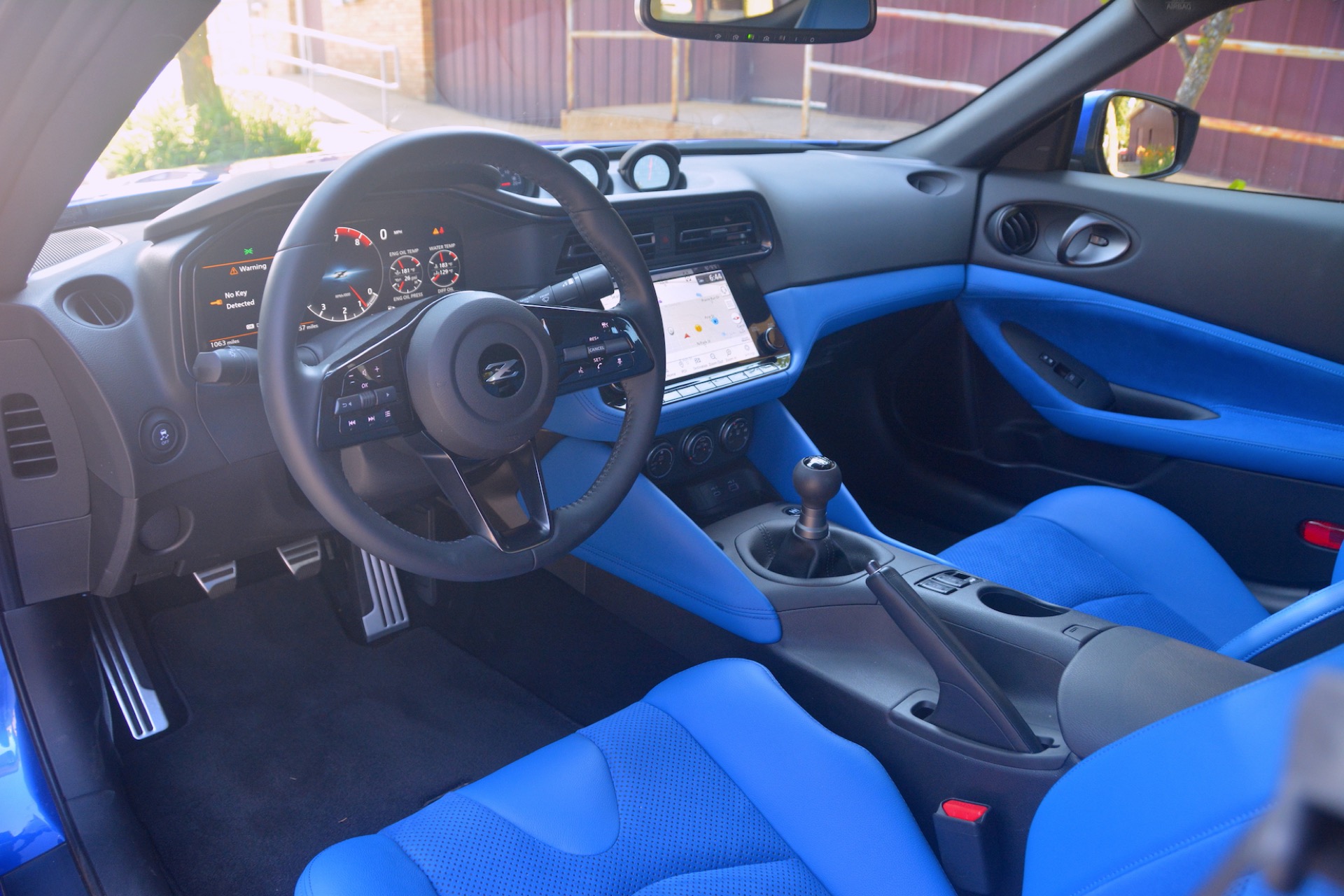
The windows are short, giving outward vision a pillbox slit feel. but the view out over the hood is good, and we loved the way the rear fenders filled the side mirrors. Taller drivers will find the rear-view mirror to be a vision obstruction, but it likely won’t matter as much for shorter drivers. At 6’1”, I found myself wishing it had a periscope ala the original Lamborghini Countach that was integrated into the roof. It would be both practical and really trick. The steering wheel is adjustable for reach and height.
The shifter knob falls readily to hand and snicks into gear easily. Snick it into first gear, push in the clutch, and press the Start button. The 3.0L V6 rumbles to life. It’s quiet but has a threatening tone to it. It’s a perfect engine note for a sporty daily driver – not too much, not too little. Snick the shifter into first gear, let off the clutch and pull out into traffic. The engine eagerly propels the car up the road. There are large blind spots due to the thick B-pillars, but if the mirrors are adjusted correctly it’s easy to get by. There are also lights on the A-pillar that illuminate whenever someone is in your blind spot areas. Most cars have them built into the mirrors but Nissan has chosen to put them *inside* the car on the A-pillar. I have to say that I prefer Nissan’s method. It’s a small but appreciated detail.
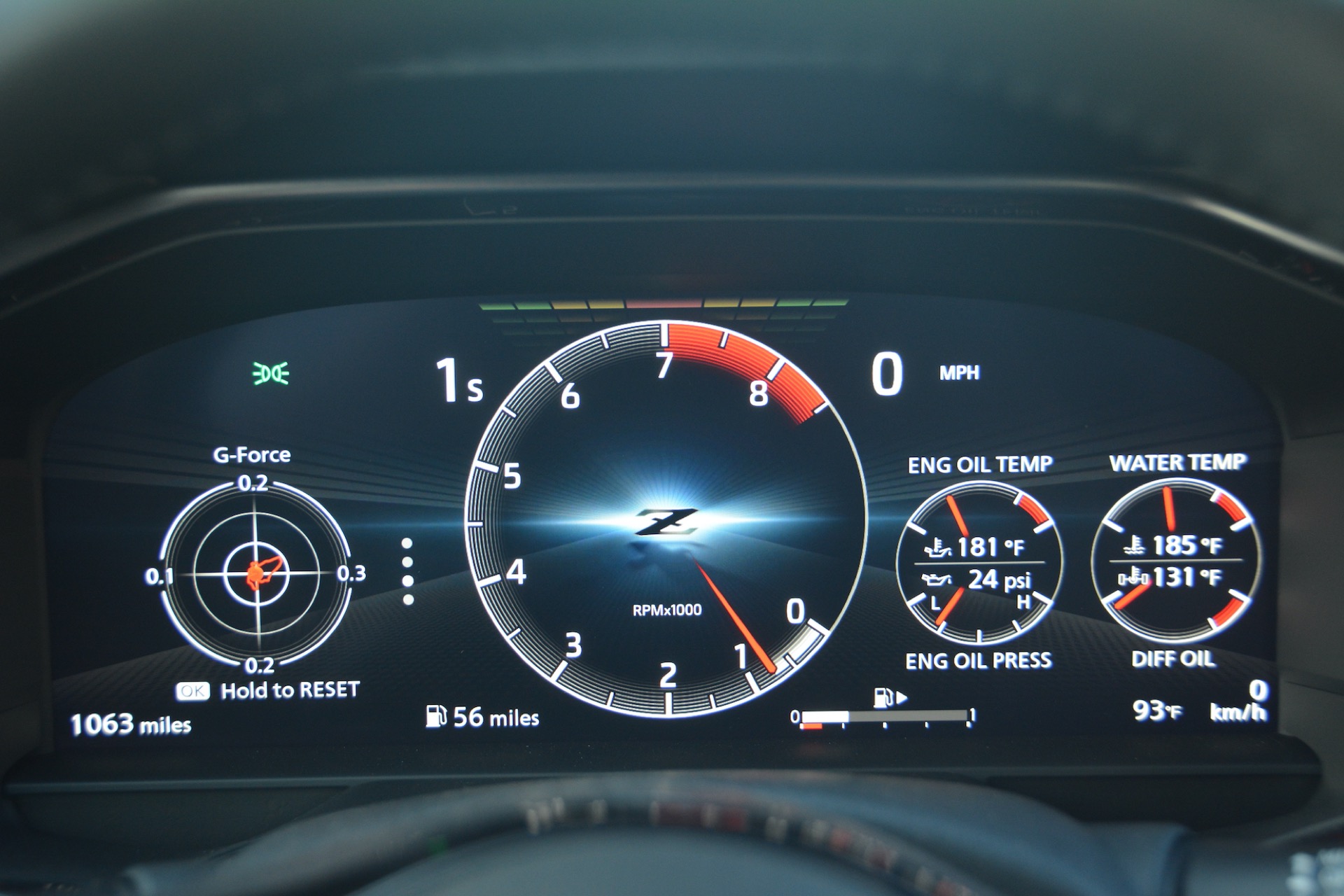
Grab second gear and, as traffic opens up, nail the throttle. The Z quickly speeds up, then SURGES up the road, catching traffic quickly. The flat torquey powerband is a joy. Grab third gear and slip past a few slower cars. Grab fourth, letting off the throttle and coasting up the road. The freeway on-ramp is quickly approaching. Blip the engine and downshift to third. Or, if you have enormous feet like I do and lack any sense of coordination such that women give you a wide berth at dances, press the sport shift mode button let it blip the engine for you. Downshift to second and listen to the engine blip again. Brake hard, then toss it into the corner of the on-ramp. The Z glides through the curve effortlessly. Hard on the accelerator again and the engine roars as it surges up the on-ramp. Grab third gear and shoot around the cloverleaf, enjoying how the bolstered seats holds you in place as the g-forces build. The car is stable and inspires confidence quickly. As the cloverleaf straightens out and merges with the freeway, throttle down and grab fourth. The Z rockets up the road. The torque hits you like a firehose in the chest. Click your turn signal – a confident crisp action – merge into traffic and quickly weave past the slowpokes that are half asleep behind the wheel. Get into a open spot, grab the right lane and drop down to the speed of traffic.
It’s very quiet inside at freeway speeds. The suspension and tires absorb a lot of the bumps and expansion joints but you still feel them. The suspension isn’t as advanced as some sports cars since it doesn’t have active damping, but you’re left with an honest, mechanical suspension that does a very good job without getting too costly or complicated. There are no drive modes, which is increasingly unusual in this day and age, but I like that about the Z. It’s not trying to be everything to everyone. It’s a damned good sports car and that’s all it’s trying to be. That’s honest. That’s admirable.
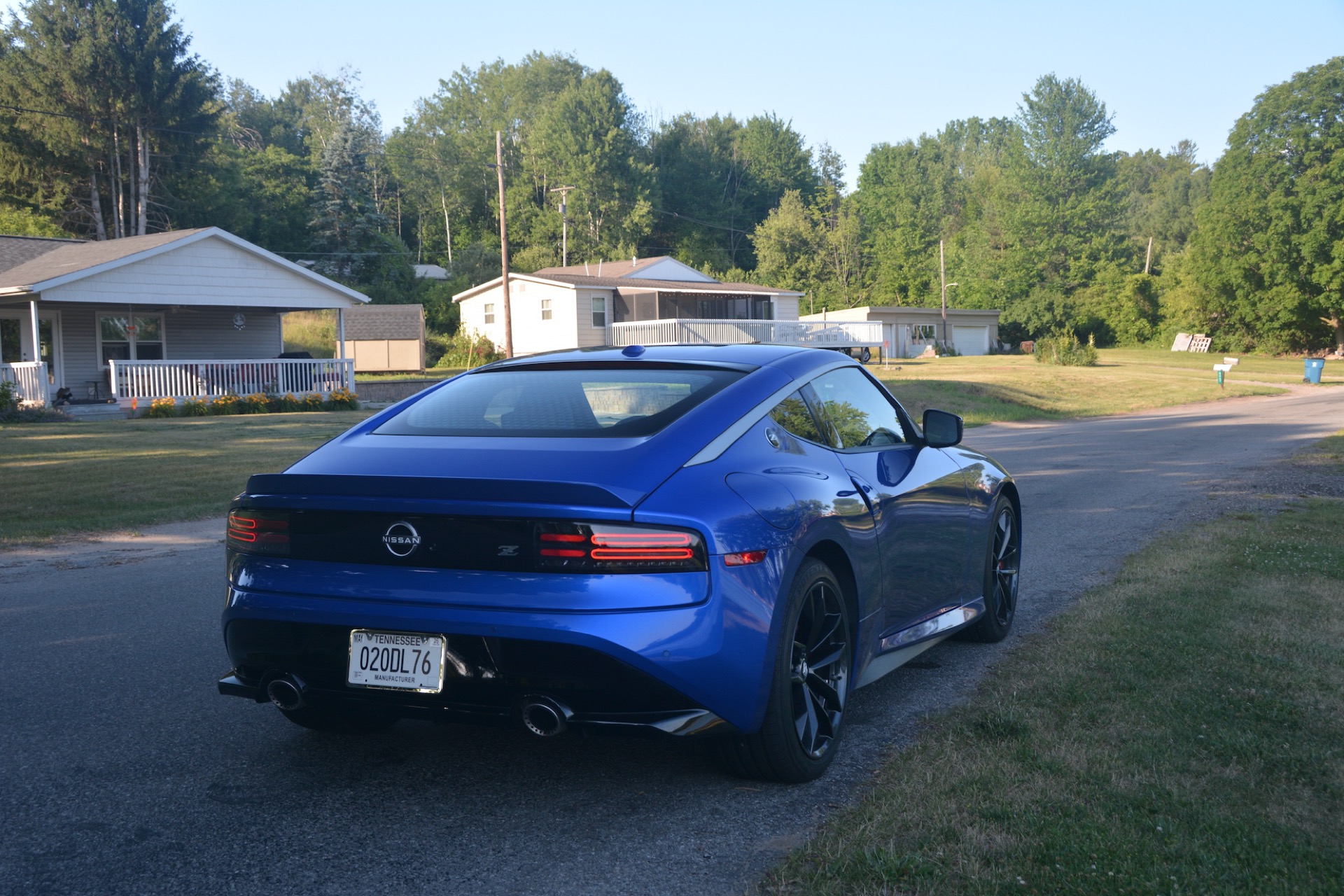
Exit the freeway, riding the centrifugal g’s around the cloverleaf, finally stopping at the red light. When it turns green, roar away and grab the first fun rural road you can find. Dive into the curves and the Z simply obeys your every input, almost to the point of knowing what you want before you do. The steering is intuitive and straightforward. Just like it should be. Is that a deer about to step into the road? Nail the brakes and it stops quickly, without fuss or worry. The car retains its composure the whole time. The nose doesn’t dive, nor does the car’s body lean much. The car feels solid, like it was shaped from a solid ingot of titanium. We didn’t hear one creak or rattle while we had it.
The Z is a competent little sports car. Much more competent that I was expecting, honestly. The harder you drive it, the more is seems to shrink around you, becoming an extension of you as a driver. And that’s where the Z’s strengths really shine. It’s one of the most honest and straightforward sports cars that I’ve ever driven. So many of todays sports cars exhibit an almost schizophrenic attitude about their performance. To get the most out of it, you have to press several buttons or scroll through endless menus to turn various nanny aids off. With the Z, the performance is right there, waiting for you to utilize it. No tricks, no novelties, no gimmicks. Just a dynamic quality performance driving experience. I can only think of a handful of sports cars as focused and committed to the mission of performance driving. The Z is in rare company.
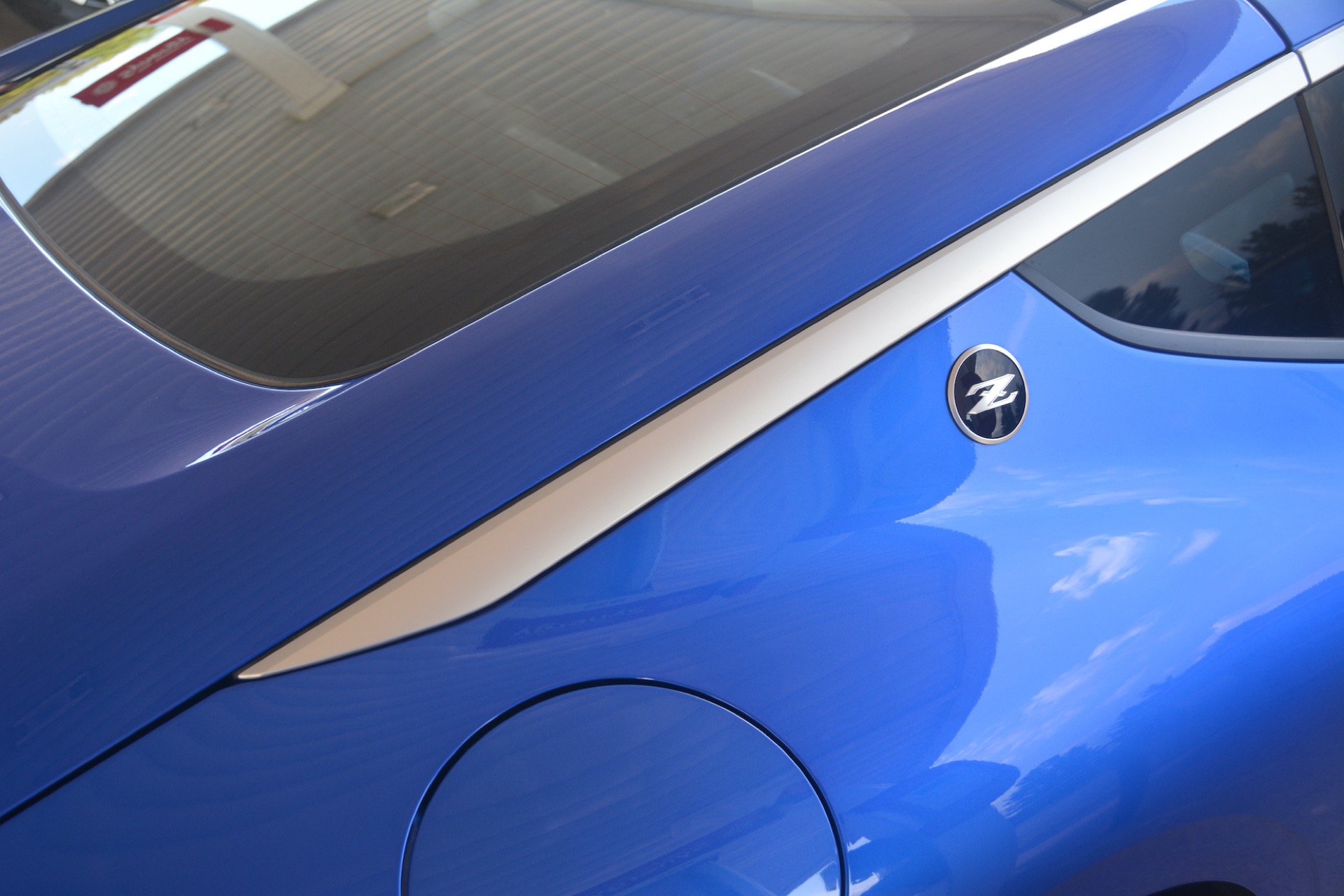
The EPA has given the Z a fuel economy rating of 18 mpg in the city and 24 mpg for an average of 20 mpg combined. It’s no fuel sipper, but then when you feel the firehose rush of the turbo engine rapidly propelling you towards the horizon you completely understand the trade-off.
I was surprised by how many people took note of the Z while we had it. Every time we took it out, we’d get at least one but usually more than one positive comment or thumbs-up. Heads would swivel as we drove by. It’s a car people notice, likely due to the throwback retro styling and the quiet growl of the engine.
The price isn’t bad either. Our Performance level model, with a few minor options, stickered at about $56,000. More than a Miata MX-5, less than a Corvette, right in line with a Supra.
We were surprised by the Z in the best way possible. It’s been awhile since we’ve climbed behind the wheel of one and it’s obvious Nissan hasn’t been neglecting the platform. As competitors like Toyota’s new Supra GR 3.0 have appeared on the market, Nissan has taken note and kept improving the Z to better compete on the track and in the market. It’s a heck of a car and we thoroughly enjoyed it.
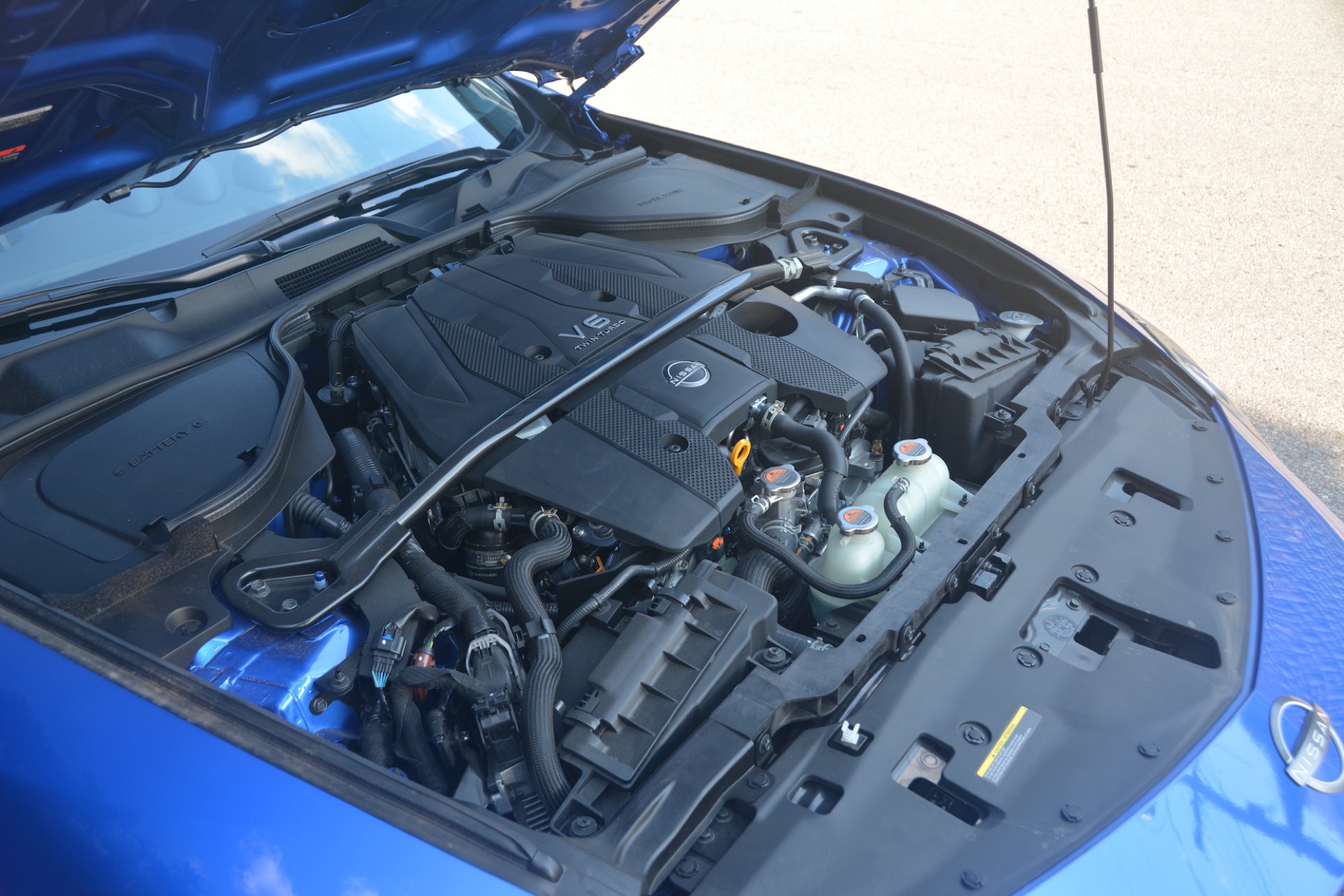
Performance: 8
Handling: 8
Design: 7
Interior: 8
Infotainment: 7
Sound: 7
Fun: 8
Overall: 8
